Which of the following radiologic procedures requires that a contrast medium be injected into the renal pelvis via a catheter placed within the ureter?
Retrograde urography
Nephrotomography
IVU
Retrograde urography
Which of the following statements is (are) correct regarding the parietoacanthial projection (Waters' method) of the skull?
1. The head is rested on the extended chin.
2. The orbitomeatal line (OML) is perpendicular to the (IR).
3. The maxillary antra should be projected above the petrosa.
1. the head is rested on the extended chin, 3. the maxillary antra should be projected above the petrosa.
In the RPO position of the cervical spine, which anatomy is demonstrated:
(1) Left intervertebral foramina
(2) Right pedicles
(3) Right intervertebral foramina
(4) Left pedicles
1. Left intervertebral foramina, 4. Left pedicles
The bilateral AP "frog leg" position of the femoral neck places the patient in a supine position with the femora:
1- adducted 40 degrees from the horizontal
2- abducted 25 degrees from the vertical
3- abducted 40 degrees from the vertical
3- abducted 40 degrees from the vertical
To demonstrate the first two cervical vertebrae in the AP recumbent projection, the patient is positioned so that:
1- A line between the maxillary occlusal plane and the mastoid tip is vertical.
2- The acanthiomeatal line is vertical
3- A line between the mentum and the mastoid tip is vertical.
1- A line between the maxillary occlusal plane and the mastoid tip is vertical.
The ideal position for demonstrating polyps and ulcers of the pylorus, duodenal bulb, and C-loop of the duodenum:
PA
Right Lateral
LPO
RAO
RAO
Single contrast BE studies are likely to demonstrate:
1- anatomy/tonus
2- mucosa
3- intraluminal lesions
1- anatomy/tonus
For the average patient, the CR for a lateral projection of a barium-filled stomach should enter:
1- midway between the mid-coronal line and the anterior abdominal surface
2- Perpendicular to the level of L2
3- at the mid-coronal line at the level of the level of the iliac crest
1- midway between the mid-coronal line and the anterior abdominal surface
The junction of articulation between the lambdoidal suture and the squamosal suture exists between what bones?
At the junction of the temporal, parietal, and occipital
At the junction of the occipital, frontal, and temporal
At the junction of the temporal, parietal, and occipital
Which of the following projections of the hand places the thumb in an oblique position?
PA oblique, external rotation
PA
Lateral in extension
PA oblique, external rotation
Blunting of the costophrenic angles seen on a PA projection of the chest can be an indication of:
1- Ascites
2- Emphysema
3- Pleural Effusion
3- Pleural Effusion
Some common mild side effects of intravenous administration of water-soluble iodinated contrast agents include:
1. Flushed feeling
2. Bitter taste
3. Urticaria
1. Flushed feeling, 2. Bitter taste
To obtain an exact axial projection of the clavicle, place the patient
1- supine and angle the central ray 15° cephalad.
2- in a lordotic position and direct the central ray at right angles to the coronal plane of the clavicle.
3- supine and angle the central ray 30° caudally.
2- in a lordotic position and direct the central ray at right angles to the coronal plane of the clavicle.
A patient is usually required to drink barium sulfate suspension to demonstrate which of the following structures?
1. Esophagus
2. Pylorus
3. Ilium
1. Esophagus
2. Pylorus
3. Ilium
Which surface of the forearm must be adjacent to the IR to obtain a lateral projection of the fourth digit/finger with optimal recorded detail?
Medial
Medial
To position a patient for a Danelius-Miller axiolateral cross-table projection of the hip:
The knee and the hip of the unaffected leg are flexed and elevated.
The knee and the hip of the unaffected leg are flexed and elevated.
Which of the following structures is (are) located in the right upper quadrant (RUQ)?
1. Spleen
2. Gallbladder
3. Hepatic flexure
2. Gallbladder, 3. Hepatic flexure
To radiograph an infant for suspected free air within the abdominal cavity, which of the following projections of the abdomen will demonstrate the condition with the least patient exposure?
Left lateral decubitus without grid
Left lateral decubitus without grid
Which of the following statements is (are) true regarding the PA axial projection (Caldwell) of the cranium?
1. The central ray is directed caudally to the OML.
2. The petrous pyramids are projected into the lower third of the orbits
3. The frontal sinuses are visualized
1. The central ray is directed caudally to the OML.
2. The petrous pyramids are projected into the lower third of the orbits
3. The frontal sinuses are visualized
Which of the following is a major advantage of the double-contrast UGI examination over the single-contrast UGI?
Small lesions on the mucosa are better demonstrated
Small lesions on the mucosa are better demonstrated
The tarsometatarsal joins have Ginglymus ( Hinge) movements?
False
False
Which of the following positions will most effectively move the gallbladder away from the vertebrae in an asthenic patient?
LAO
LAO
The innominate bone is located in the
pelvis
pelvis
What is the position of the stomach in a hypersthenic patient
High and Horizontal
High and Horizontal
Which of the following positions/projections is most likely to offer the best visualization of the pulmonary apices?
AP axial lordotic
AP axial lordotic
Spondylolysis is the dissolution of a vertebra, such as from aplasia
True
True
Which of the following are the most common routine projection/position (s) for demonstration of the sternum?
Right anterior oblique and lateral
Right anterior oblique and lateral
A patient presents with a potential intertrochanteric hip fracture. After the technologist has taken an initial AP projection, which of the following is the best way to proceed?
Use a cross-table lateral projection, with the central ray directed perpendicular to the femoral neck
Use a cross-table lateral projection, with the central ray directed perpendicular to the femoral neck
Although they are both classified as synovial joints, the hip joint is ______ while sacroiliac joints are ______.
diarthrotic; amphiarthrotic
diarthrotic; amphiarthrotic
Which of the following conditions would require an increase in exposure factors?
1. Congestive Heart Failure
2. Pleural Effusion
3. Emphysema
1. Congestive Heart Failure, 2. Pleural Effusion
Which of the following sinus groups is best demonstrated with the patient positioned for a parietoacanthial projection (Waters method) with the CR directed through the patient's open mouth?
Sphenoidal
Sphenoidal
In what order should the following studies be conducted?
1. Barium Enema
2. Intravenous urogram
3. UGI
2,1,3
Which of the following positions would demonstrate the right lumbar zygapophyseal articulations closest to the IR?
RPO
RPO
Correct preparation for a patient scheduled for an UGI series is most likely to be
NPO after midnight
NPO after midnight
In which of the following conditions is a double-contrast BE essential for the demonstration of the condition?
1. Polyps
2. Colitis
3. Diverticulosis
1. Polyps, 2. Colitis
With the patient in PA position and the OML and The CR perpendicular to the IR, the resulting image will demonstrate the petrous pyramids.
completely within the orbits
completely within the orbits
Fractures that can be due to trauma, osteoporosis, or metastatic disease could be
1- Stress Fractures
3- Compression Fractures
1- Stress Fractures
3- Compression Fractures
The liver is in the
Upper Right Quadrant
Upper Right Quadrant
All of the following bones are associated with condyles except the
Fibula
Fibula
Visualization of the nasal bones is best demonstrated with a
Lateral Projection of both sides
Parietoacanthial Projection, Waters Method
Lateral Projection of both sides
Parietoacanthial Projection, Waters Method
Shoulder arthrography is performed to :
1. evaluate humeral luxation
2. demonstrate complete or partial rotator cuff tear
3. evaluate the glenoid labrum
2. demonstrate complete or partial rotator cuff tear, 3. evaluate the glenoid labrum
Which of the following precautions should be observed when radiographing a patient who has sustained a traumatic injury to the hip?
1. When a fracture is suspected, any required manipulation of the affected extremity must be performed by a physician.
2. The axiolateral projection should be avoided.
3. To evaluate the entire region, the pelvis typically is included in the initial examination.
1. When a fracture is suspected, any required manipulation of the affected extremity must be performed by a physician, 3. To evaluate the entire region, the pelvis typically is included in the initial examination.
Which is the portion of the alimentary canal where digestion and the absorption of the food occur?
Small Intestine
Small Intestine
Where is the center of the IR positioned for the AP abdominal radiograph done in the Upright position?
2 inches above iliac crests
2 inches above iliac crests
A 6-year-old patient aspirated a coin. Which bronchus would the coin most likely enter and why?
The right because it is more vertical
The right because it is more vertical
Which position will best demonstrate the lumbar intervertebral foramina?
Lateral Position Lumbar Projection
Lateral Position Lumbar Projection
Contrast agents that can be used during excretory urography include all of the following except:
Barium Sulfate
Barium Sulfate
Which of the following radiographic procedures uses an intrathecal route of introducing a drug or contrast medium?
Myleogram
Myleogram
A substance or method used to cleanse the large bowel prior to a barium enema is called
1. a cathartic
2. a cleansing enema
3. a purgative
1. a cathartic
2. a cleansing enema
3. a purgative
Which of the following conditions is characterized by "flattening" of the hemidiaphragms?
Emphysema
Emphysema
The articular facets of L5-S1 are best demonstrated in a/an:
30° oblique
30° oblique
What part of the "Scotty dog," seen in a correctly positioned oblique lumbar spine, represents the lumbar transverse process?
Nose
Nose
Elements of correct positioning for PA projection of the chest include:
1. weight evenly distributed on feet
2. elevation of the chin
3. shoulders elevated and rolled forward
1 and 2 only
Which position of the shoulder demonstrates the lesser tubercle in profile medially?
Internal rotation
Internal rotation
When performing the AP projection of the scapula, The central ray should be directed toward a point 2 inches __________ to the Coracoid process
Inferior
Inferior
Which of the following examinations involves the introduction of a radiopaque contrast medium through a uterine cannula?
Hysterosalpingogram
Hysterosalpingogram
Correct preparation for a patient scheduled for a lower GI series is most likely to be
cathartics and cleansing enemas
cathartics and cleansing enemas
Which of the following is/are effective in reducing exposure to sensitive tissues for frontal views during scoliosis examinations?
1. Use of PA position
2. Use of breast shields
3. Use of compensating filtration
1. Use of PA position
2. Use of breast shields
3. Use of compensating filtration
Which of the following examinations most likely would be performed to diagnose Wilms' tumor?
IVU
IVU
Which of the following is a functional study used to demonstrate the degree of AP motion present in the cervical spine?
Flexion and extension laterals
Flexion and extension laterals
In a lateral projection of the nasal bones, the CR is directed
half inch distal to the nasion
half inch distal to the nasion
Deoxygenated blood from the head and thorax is returned to the heart by the
superior vena cava
superior vena cava
What projection of the calcaneus is obtained with the leg extended, the plantar surface of the foot vertical and perpendicular to the IR, and the CR directed 40 degrees cephalad?
Axial plantodorsal projection
Axial plantodorsal projection
With a patient in the PA position and the OML perpendicular to the table, a 15 degree-20 degree caudal angulation would place the petrous ridges in the lower third of the orbit. To achieve the same result in an infant or a small child, it is necessary for the radiographer to modify the angulation to
10 degree-15 degree caudal
10 degree-15 degree caudal
A patient unable to extend his or her arm is seated at the end of the x-ray table, elbow flexed 90 degrees. The CR is directed 45 degrees medially. Which of the following structures will be demonstrated best?
1. Radial head
2. Capitulum
3. Coronoid Process
1 and 2 only
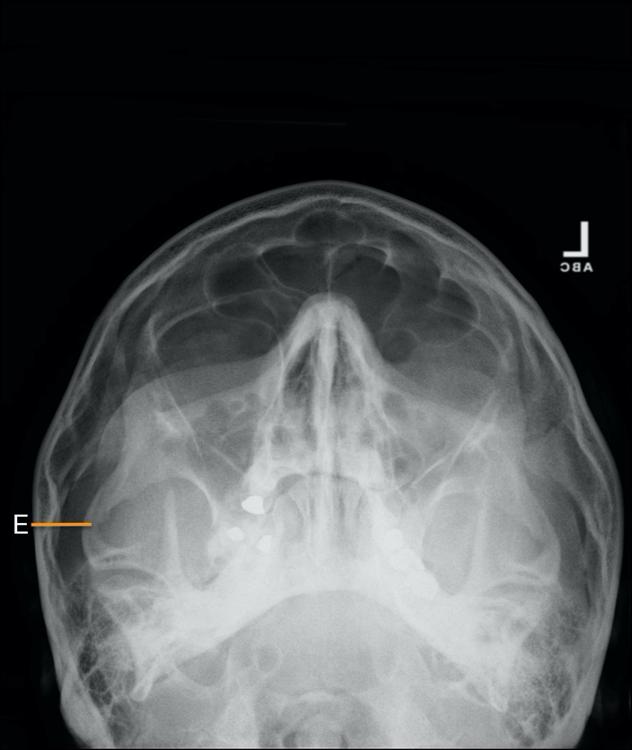
Identify the structure that is identify by letter E:
- Zygoma
- Mandible
- Petrous Ridge
- Maxillary sinus
- Zygoma
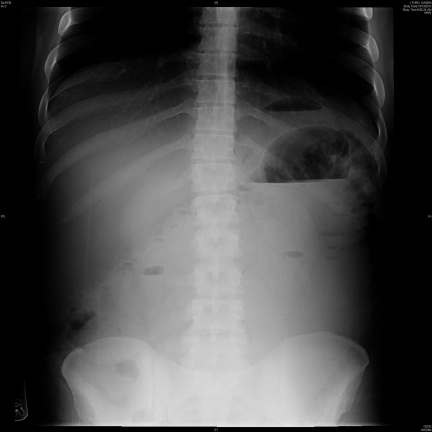
What is the patient position utilized in this radiograph?
- supine
- Lateral decubitus
- Prone
- Erect
- Erect
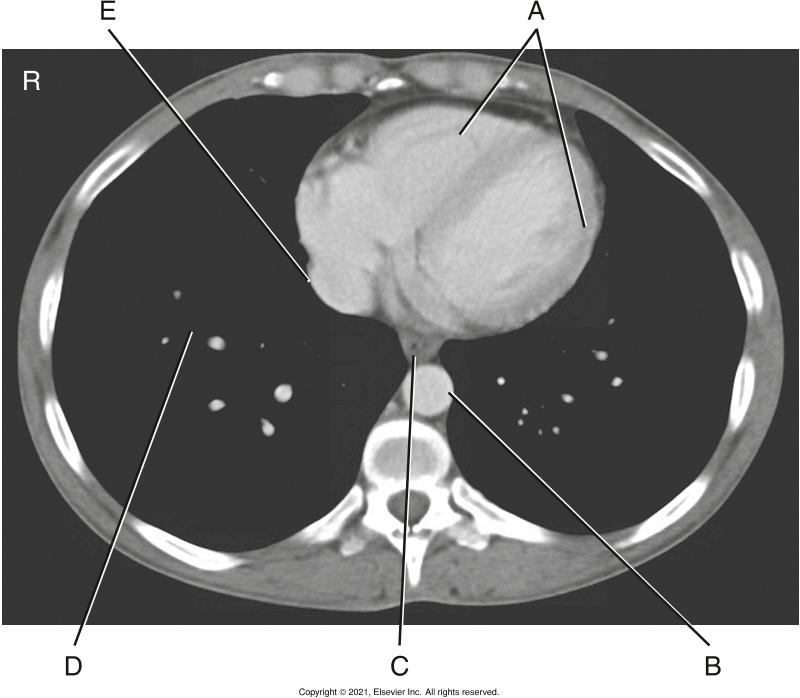
In the image below letter B is the?
- Right lung
- Esophagus
- Descending aorta
- Heart
Descending aorta
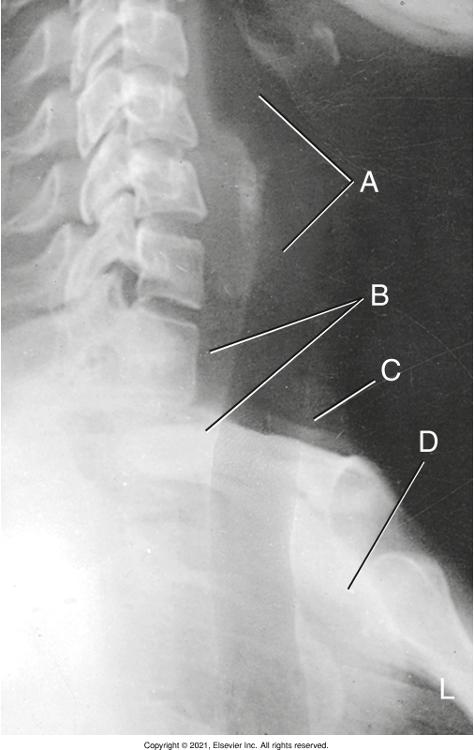
Identify the structure that is mark as an letter A
- Esophagus
- Region of the thyroid gland
- Lateral upper airway
- Air-filled trachea and larynx
Air-filled trachea and larynx
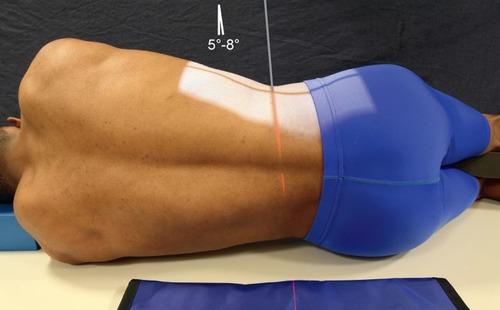
Which of the positions illustrated in Figures A will best demonstrate the lumbar intervertebral foramina?
1- Lateral position lumbar projection
2- Left Anterior Oblique Position
3- Left Posterior Oblique Position
1- Lateral position lumbar projection